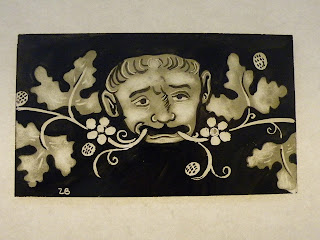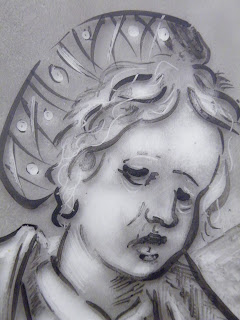Below you will see a selection of close up pictures of the Original Flemish roundel.
Object: Roundel
Place of origin: Flanders, Belgium
Date: 1520
Size: 35.7cm
I visited the V&A where this roundel can be viewed in their stunning stained glass section. It was a project that I was given as part of my University course. This was for my traditional glass painting. I decided on this roundel purely for the challenge that it would give me, and it certainly lived up to it.
Above you can see a group of people listening to St Peter. I love the way you can get completely lost in they're faces, there is a huge amount of detail and a complete understanding of how to use light.
This Image is showing you a wider angle of the roundel, you are able to see what I was faced with when I first saw this window. It is a true masterpiece, and completely breathtaking when you see it in the flesh.
Here you can See the border more closely, its so striking with its dark black brown paint and then the shots of yellow and varied controlled sections of light.
Everywhere you look you see more detail, the beautiful hats and gold coin purses, It looks as tho you could pluck the pearls off her hat.
St Peter has such a wonderful face, a full beard and expressive wild hair.
This picture allows you to really look at the drapery and how the stick work and shading all comes together to create this sumptuous and endless fabric. Keep in mind that each of these figures are around 8-10cm.
The castle just thrown in because they could. This castle is so small it was giving me nightmares for weeks.
Simon the Sorcerer. He has such wonderful hair, a true use of weight of line and stick work.
The peacocks around the border. You can see there is paint loss on these which makes it difficult to see whats really going on, but it appears they are striding over a scroll, the lettering on the scroll is all but gone so that is very challenging, but since Flemish roundels were mainly used for domestic use it could be a family motto, or a saying from the bible.




















